Overview of ‘Karl Foerster’
Feather reed grass (Calamagrostis x acutiflora) is a dramatic ornamental grass used in many types of landscapes. Probably the most common cultivar is ‘Karl Foerster’. When the Perennial Plant Association named this cultivar their 2001 Perennial Plant of the Year®, they called it “one of the most versatile, attractive, and low maintenance ornamental grasses.”
This is a cool season grass, hardy in zones 3-9, so the deep green, glossy foliage appears early in the spring. In cold climates like Wisconsin, the color lasts through late fall or early winter when it turns a golden tan color, but in mild climates the foliage may remain green. The plants grow erect, in a narrow clump 2-3 feet tall and less than 2 feet wide.
In early summer, flowers stems 5-6 feet tall appear. This cultivar blooms a few weeks earlier than common feather reed grass. The heads of the loose, feathery inflorescences emerge green, then open to airy, rosy-pink plumes. After a few weeks the color changes to dark maroon, then to bronze, and finally to golden tan. The plants flower stalks remain upright through the winter to provide winter interest.
C. x acutiflora is thought to be a natural hybrid of C. epigejos (native to Europe, Asia and Africa) and C. arundinacea (native to Eurasia, China and India) that occurred in the Hamburg Botanical Garden. It was introduced to the industry as an ornamental in 1950 by German nurseryman Karl Foerster. It was brought into the United States from Denmark in 1964. It is almost identical to C. x acutiflora ‘Stricta’ (so identical that these plants are often confused by some nurseries) but ‘Karl Foerster’ does not self-seed.
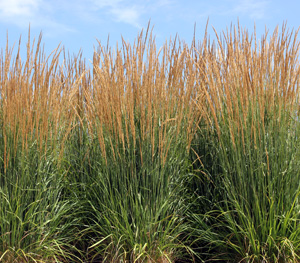
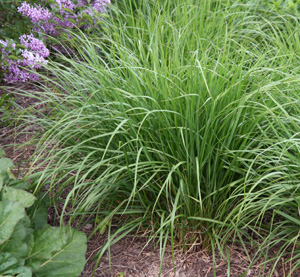
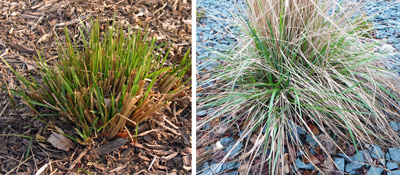
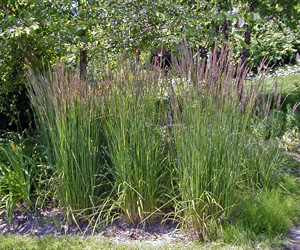
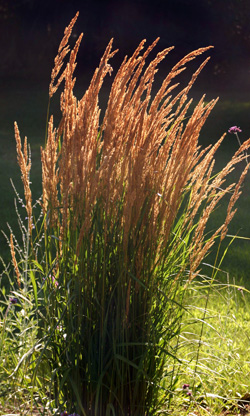
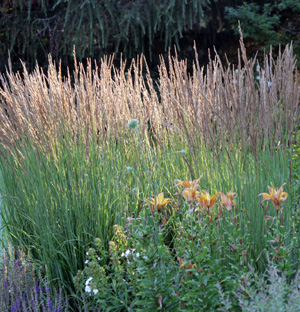
Landscape Use
Plant in a spot where the afternoon sun will shine on the seedheads, making them appear almost golden in color, for a dramatic effect. It is also useful in patio pot containers, as a backdrop for roses or as a seasonal hedge or screen. ‘Karl Foerster’ feather reed grass combines well with other perennials, especially late summer and fall-blooming perennials such as Coreopsis, Echinacea, Liatris, and Rudbeckia.
C. x acutiflora ‘Karl Foerster’ is excellent as a specimen plant, providing a vertical accent in the landscape, or as a massed planting. The slightest breeze sets this grass in motion and the graceful movement is a highlight for any landscape. In heavy rain or wind, the stems may flop in all directions but quickly return to vertical when dried off.
Feather reed grass also makes a good fresh or dried cut flower for arranging. Stems cut before the flowers mature will last for months in an arrangement, maintaining the golden tan color.
General Care of ‘Karl Foerster’
This long-lived perennial grass grows best in full sun to partial shade. It prefers moist, well-drained, fertile soils, but is relatively drought tolerant once established. Unlike many of the other ornamental grasses it does well in heavier clay soils. Fertilization may be required to produce maximum height in infertile soils. It has no serious disease or insect problems and is not favored by deer. It may flop over if grown in shade.
Little maintenance is required except to cut back the stems to about 6 inches annually. Since feather reed grass starts its growth early in spring, cut back the previous year’s growth in late winter or very early spring to avoid damaging the new growth.
Propagating ‘Karl Foerster’
Feather reed grass is best propagated by division in the fall or spring. Large clump division may be done in the fall with a good show of flowers the following spring. Smaller clumps will require a second growing season to fully develop a mature flowering effect. “Karl Foerster’ is sterile, so it will not reseed in the landscape.
– Susan Mahr, University of Wisconsin – Madison
Last Update: Bruce Spangenberg, UW-Madison Extension, 2025





 Aster, Symphyotrichum spp.
Aster, Symphyotrichum spp. Fascinating Fasciation
Fascinating Fasciation Alternatives to Lawn: Groundcovers
Alternatives to Lawn: Groundcovers Marigolds
Marigolds


